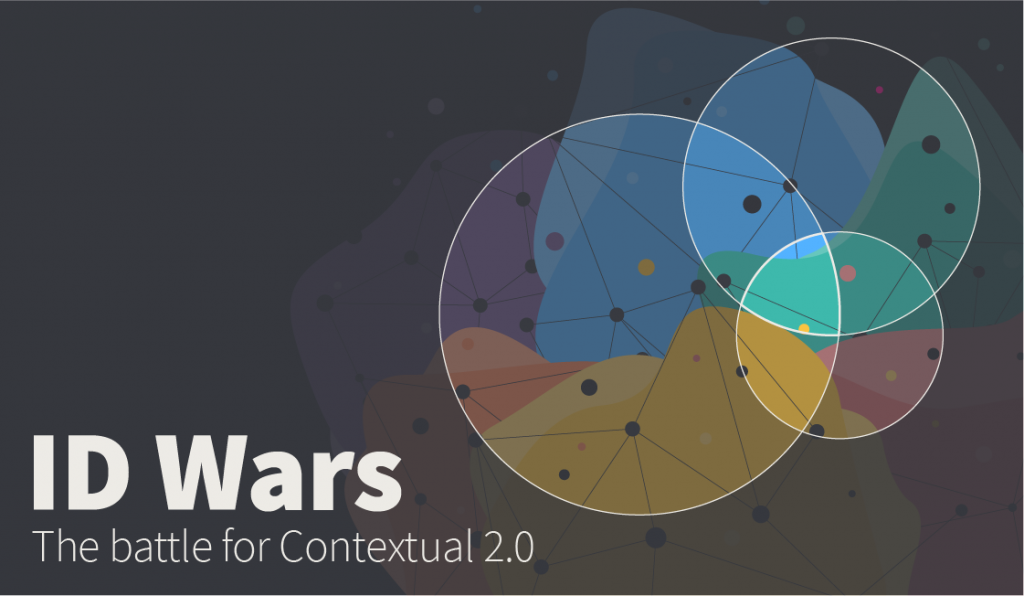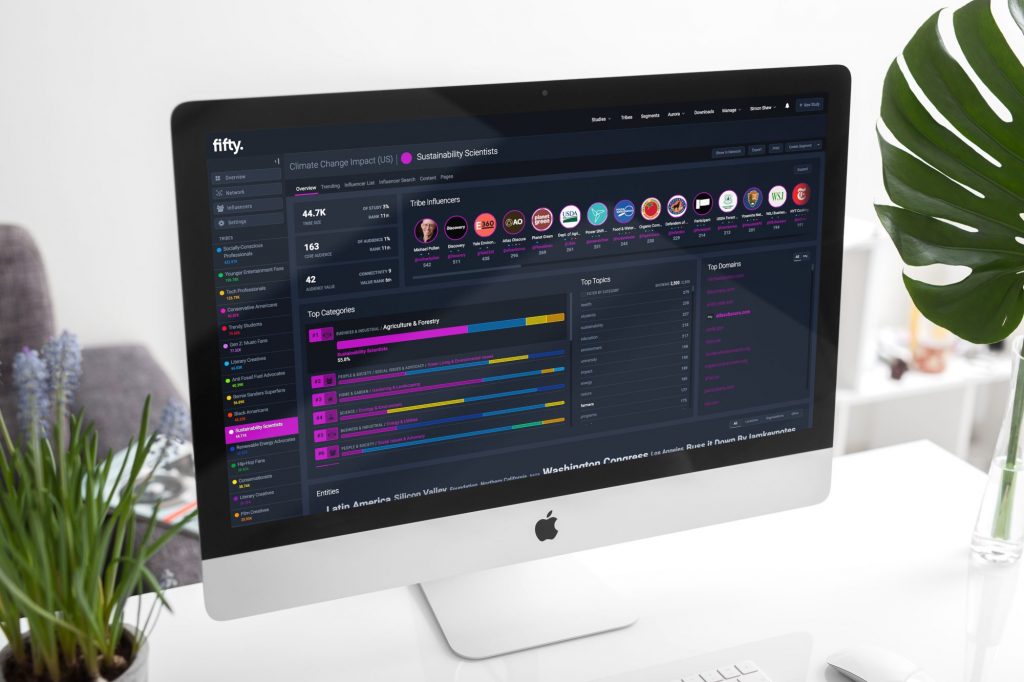ID Wars: The Battle for Contextual 2.0
by Mathew Broughton on 11th Jan 2022 in News

In association with Fifty.
In this contributed article written for ExchangeWire in association with Fifty, Robert Webster, founder of Canton Marketing Solutions, outlines the current state of play in contextual and how next-generation solutions are set to revolutionise media planning and buying in years ahead.
Throughout my career, I have long made it a priority to look out for up-and-coming solutions set to disrupt the market. As such, I have done extensive work analysing and designing products in areas like DMP, behavioural targeting, attribution and programmatic buying, to name just a few. In more recent times, as privacy and identity have come to the fore, so too have areas such as CDPs, data clean Rooms and cookie-free data. Part of this work involved analysing new contextual solutions, and it was in this context I initially started speaking with, and more recently working with, Fifty Technology and their contextual product, FiftyAurora. What follows is my analysis of where the market is and what a truly next generation contextual solution will look like - Contextual 2.0.
Contextual targeting has been a mainstream of digital display buying since at least the start of the programmatic era around the turn of the last decade. Yet contextual 1.0 was built for an era where it worked alongside cookies. Advertisers are slowly waking up to the fact that they cannot reach their audiences today using IDs on Apple devices, making a mockery of their efforts to reach the richest billion users on the planet (Apple users). In response to this, advertisers are increasingly looking for new and different tools to thrive.
This is the opportunity that is driving so many companies to launch new contextual solutions. This includes many players originally in the behavioural targeting space like Captify, retargeters like Criteo, former consultancy companies like Silverbullet, alongside a raft of newcomers and refreshed older solutions. Expect programmatic buyers to be inundated with dozens of new options in this space over the next 18 months. To succeed, these offerings will need to be much better than what has come before. With the original players so well entrenched, there is no room for copycat solutions. Furthermore, to succeed in what will be a hugely competitive Contextual 2.0 market with dozens of new solutions being launched, companies need to show how they can succeed in a world without cookies and other IDs, and provide marketers with complete solutions (rather than point solutions). Many copycat solutions will come and go in the next few years, but for those that can truly offer marketers the tools they need, new giants will be made.
Contextual 1.0 - powerful keywords and categories

Robert Webster, founder, Canton Marketing Solutions
The original players in the contextual space generally started 10 to 15 years ago and have been highly prominent in the programmatic era of display advertising. The first and by far the most dominant, of course, is Google. Built from its search technology, Google has for a long time offered strong contextual offerings, at zero marginal cost, on its DSP (DV 360) and on the Google Display network (aimed at longer-tail buyers). Google's solution offering keywords and categories for advertisers is widely used and generally quite effective thanks to Google's optimisation algorithms, but otherwise not particularly feature rich. Whilst Google's contextual data dominated on its own platform, other technologies such as Grapeshot and Peer 39 among others, offered similar to Google, albeit at a (fairly low) additional cost on third party DSPs (led by The Trade Desk, Appnexus, and MediaMath). What often differentiated these tools from Google was their ability to model keywords based on a pixel on a website, leading to a type of keyword lookalike solution.
Overall, these offerings have been tremendously successful at offering powerful keyword and category-based data - primarily for direct response campaigns. All of them are taking in data from a vast number of URLs, websites and apps and using highly advanced techniques to process that data into keywords and categories. Outside of Google, these solutions also offer the ability to model data against a website's own users and join a DSP’s measurement and optimisation framework. These solutions have set the benchmark against which, if they cannot compete, any Contextual 2.0 solution will fail.
Contextual 1.0 designed to work alongside cookies
It is important to remember that Contextual 1.0 solutions have been designed to be utilised alongside cookie-based measurement and other cookie based audiences and planning techniques. They have not been designed to reach all parts of a media plan nor, indeed, conduct measurement. As such, and as we shall discover below, they can be ineffective when cookie-based measurement and audiences are not available to fill gaps in the media plan that Contextual 1.0 simply cannot reach.
This also creates a critical weakness for Contextual 1.0. Without the ability to reliably track post-impression performance without an ID, how can you plan or verify that the keywords and categories you are buying are right for the advertiser? How do you know the campaign is working and optimise it? This challenge was not considered when Contextual 1.0 was designed and so far has not been addressed.
The Contextual 1.0 incumbent barrier
One major problem for the new contextual solutions is that they are finding the existing solutions to be a barrier to install on major DSPs. Over the last 10 years, if a data provider wanted to push data to a DSP they did it via a cookie, mobile ad ID, or some other identifier. The point here for cookieless contextual solutions is that no such ID exists. Now, DSPs can install new providers at a contextual level but so far have been loath to do so. Google will not install new contextual providers on its own DSP (nor on the GDN) to allow for competition. Other major DSPs have chosen to forgo a custom integration in favour of their existing roster of providers. This problem is likely to disappear in time but, for now, it is a fact that many contextual providers are having to offer managed services or use ungainly cookie-based integrations to deliver a product. In the land of contextual, the incumbent is king and so it takes a vastly differentiated product to knock them off their perch.
Copycat solutions are doomed
Due to the power of the incumbent, I am bemused as to why so many solutions are launching that do not sufficiently differentiate their products on what exists from Contextual 1.0. These products will talk a lot about machine learning/AI, how much data they are modelling and lookalikes - yet these are table stakes, minimum requirements to operate in this space that the Contextual 1.0 brigade solved a decade ago. Furthermore, they do not cover the needs of modern marketers (see next section).
Copycat solutions will be categorised then by relying on keywords and lookalikes, too similar to Contextual 1.0 solutions and with little idea of how to truly solve for cookieless from a planning and measurement point of view. They may have impressive sales decks but without solutions to the big questions they are doomed to fail.
Questions Contextual 2.0 Solutions must answer
In marketing, as in life, there are many routes up the mountain. Yet, if contextual is to take over from the cookie in offering marketers an ability to plan and buy audiences effectively up and down the funnel, then there are several questions or use cases they need to answer:
- To be able to target audiences that are not easily defined by keywords.
- To be able to provide actionable insights to planners and buyers.
- To be able to measure the quality of environments.
- To be able to measure results and what to optimise against without IDs/Cookies.
1. To be able to target audiences that are not easily defined by keywords or categories
Keywords are amazing for the very bottom of the funnel - if you sell a product, finding users searching or reading around that keyword can be very effective. Yet this is a marketing tactic, not a full-on marketing strategy. To have a marketing strategy you need to be able to target groups of users that fit that strategy.
Imagine you are marketing for a company selling consumer goods to families. These users don't spend their time reading about toothpaste. In this scenario, keyword targeting is next to useless. However, targeting users who fit into family audiences is highly valuable.
Imagine you are marketing for a mobile phone network. Yes, sometimes these users would research the latest handset, which would elicit a Contextual 1.0 strategy, but for a more complete strategy you would need to target your personas. Be they affluent professionals, fashionistas, gadget geeks, or families needing phones for school age children.
Solutions that build contextual targeting lists around real people modelled from social data are so much more powerful than a Contextual 1.0 provider. Moreover, what can truly separate them from the competition is the ability to build an audience that can be outputted as contextual targeting lists. For instance, when you wish to execute against a Fifty "tribe" (their word for audience) you are given a list of URLs, apps, and pages that this audience highly engages with.

2. How to provide actionable insights to planners and buyers
Contextual 1.0 companies were fairly simplistic in only offering simple insight reporting on which keywords to buy. Again, this is highly beneficial when all you want to do is run some bottom of the funnel contextual segments alongside retargeting, prospecting, and upper-funnel cookie-based audiences that could be gleaned from effective DSPs.
Yet without the ID, planners need to find a new way to build out campaigns - they need new insights into what is possible. This is where next-generation self-serve insights platforms can come in. Planners are able to model their current customers, website, social audience, influencer lists, or other seed audience, and generate rapid insights into the tribes of real people that engage with them. These insights include critical information (see below) that would allow for planners to choose (or deselect) tribes depending on their fit with the overall campaign or personas they wish to engage. Further these tribes could be served different messaging, in the example below you could imagine a supermarket brand showing different produce to the vegan audience. This power and customisation based on behaviours is exactly what planners want from a contextual tool.

3. How to understand the quality of the environment
Contextual 1.0 talks a lot about keywords and categories but tells you nothing about the quality of the environment - leaving this to be resolved by direct response measurement as it was a bottom of the funnel medium.
Yet in order to plan up and down the funnel, often without reliable measurement, quality of environment is everything. Consider how, in the past, planners would understand where their audience lived, which TV programs, newspapers and magazines they engaged with and pivot on that the understanding of the quality of the environment and so, the likely impact and sentiment from the user. This is something that Contextual 2.0 needs to offer marketers.
Fifty has exceptional capabilities here, as they are able to showcase the likely quality of the pages, how big their audiences are and understand things like viewability and dwell time. This gives marketers the ability to build strategic plans that work up and down the funnel. This further opens up the data to new types of advertising, notably high quality brand advertising (including rich media style homepage takeovers and the like) alongside the fast growing area of online video. Video is a vital part of Contextual 2.0 as it is a huge area of growth, as well as being strategically vital for advertisers. Being able to target and optimise video to audiences/tribes without keywords and control for quality, takes next-generation providers firmly away from the old providers and delivers on the promise of Contextual 2.0.
4. How to measure results and what to optimise against without IDs/Cookies
We leave the most important question to last, how to judge effectiveness without reliable attribution. In the Contextual 1.0 world, before the privacy revolution, you knew if the keywords and categories you were buying were effective or not by how many post-view sales they generated. This allowed for optimisation and rationalisation of budget. This is effectively impossible on Apple devices today and will be on Chrome in the next 18 months. As such, if you are relying on cookies to inform which keywords to buy or how to optimise, you don't have an effective cookie-less solution fit for Contextual 2.0
In contrast, with FiftyAurora the advertiser and marketer have the chance to target tribes and look for growth of those tribes in terms of visits and sales. This is effectively a modified version of the cohort strategy that is a part of Google's future. In addition, because tribes describe real people, they can be matched to real world sales, social signals, and influencers, making it possible to join up this data into a coherent marketing strategy. Tribes and audience dynamics are constantly changing and optimising to the needs of the time. Combined with the quality metrics delivered above, ability to drive brand goals like engagements, video views and visits, these solutions can be a key part of measurement and optimisation of a top-to-bottom strategy fit for the privacy-first world we are entering.
Contextual 1.0: It's time to move over for Contextual 2.0
As we have seen in this piece, Contextual 1.0 has been a very powerful set of tools for over a decade. Yet it is clearly not suited to be at the heart of a full-funnel marketing strategy.
Much work is still to be done but we have seen here how Fifty can help marketers run better campaigns and be at the heart of planning and buying across all devices. I highly recommend advertisers and marketers check it out. If you want to reach the richest billion users on the planet in 2022, you need techniques like these. If you want to thrive in the privacy-first marketing world where cookies are no more and privacy concerns are central, then tools with these capabilities like Fifty can lead the next generation of marketing data.
AudienceContextContextualSocial MediaTargeting








Follow ExchangeWire